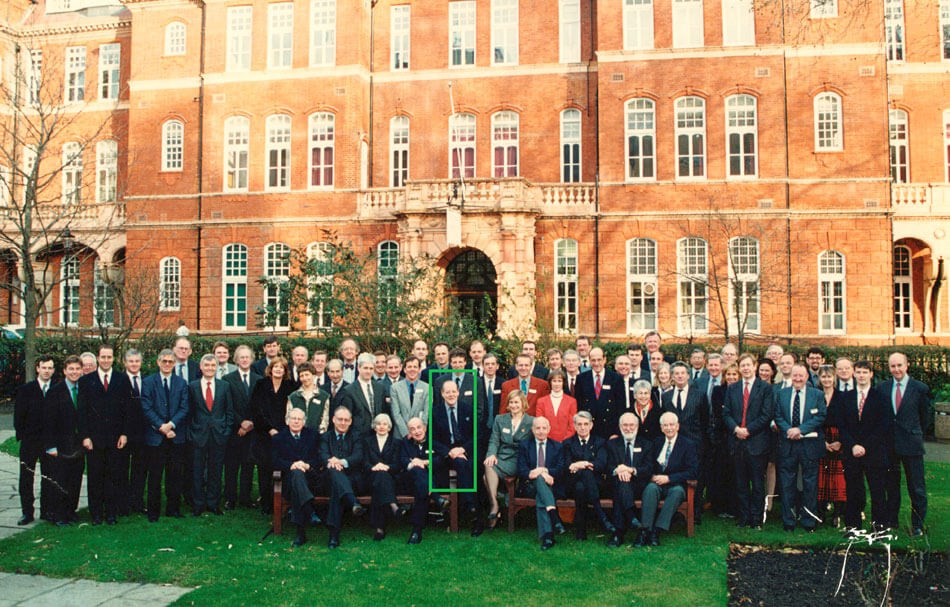Mike Sanders was Consultant Neuro-Ophthalmologist at St Thomas’ Hospital and the National Hospital, Queen Square in London, 1969 to 1999. He passed away on 25 July of this year. Over this 30-year period he had huge influence over the evolution of neuro-ophthalmology in the UK.
Amongst his trainees and fellows were the first three secretaries of the British and Ireland Neuro-Ophthalmology Society (BINOC) and the chair of the local organising committee of the 2022 European Neuro-Ophthalmology Society meeting in Birmingham. With his parallel interest in uveitis and systemic disease he established the multidisciplinary Medical Eye Unit at St Thomas’ Hospital, plus an expanded neuro-ophthalmology department at Queen Square.
His career in neuro-ophthalmology was catalysed by a one-year fellowship with Bill Hoyt in San Francisco in 1969. From this he brought back a huge enthusiasm and expertise in optic nerve disorders plus a lifelong personal bond with Dr Hoyt. This in turn supported numerous connections with many distinguished North American neuro-ophthalmologists, including Neil Miller from Johns Hopkins Hospital. It also plugged UK neuro-ophthalmology into an international fraternity of experts which hugely benefitted research and training through the BINOC group and the International Neuro-Ophthalmology Society.

Mike Sanders (centre, seated) surrounded by neurologists, neuro-radiologists, ophthalmic surgeons, medical
ophthalmologists, and vision scientists from the UK, Europe, and North America to mark his Festschrift Day in 1999.
Mike understood how neuro-ophthalmology sat at the interface between neurology and ophthalmology and that patient care was much improved by a multi-disciplinary approach, especially in the topics of swollen optic disc evaluation and the management of idiopathic intracranial hypertension. He also developed an interest and expertise in uveitis and systemic disease using the same outlook, making links with clinical immunology, and applying innovations in steroid sparing immunosuppression treatments to patient care. His clinical practice embraced both medical and surgical ophthalmology and his repertoire included optic nerve sheath fenestrations as an alternative to shunting. He was very good at spotting the diagnostic rarity that others had missed.
"Mike understood how neuro-ophthalmology sat at the interface between neurology and ophthalmology and that patient care was much improved by a multidisciplinary approach, especially in the topics of swollen optic disc evaluation and the management of idiopathic intracranial hypertension"
At his Festschrift Day on retirement in 1999 (pictured) it is notable that amongst the peers who attended and contributed talks were neurologists, neuro-radiologists, ophthalmic surgeons, medical ophthalmologists, and vision scientists from the UK, Europe, and North America.
Academically, Mike wrote and stimulated a great many published reports and case series and gave the 1997 Bowman Lecture to the Royal College of Ophthalmologists Annual Congress on papilloedema. He was very proud of the lineage of ophthalmic surgeons at Queen Square where the landscape has always been dominated by academic neurology. In particular, he always liked to say that the three clinical founders of the hospital comprised one physician, one surgeon and one ophthalmologist. This to him underlined the reality that in the realm of neurological disorders and vision, both physicians and surgeons needed the input of ophthalmology. What was true in 1859 remains the case to this day.
For me and many others he inspired us to make links with colleagues in other disciplines both locally and internationally, not to jump to conclusions with a clinical problem, and always seek to combine hard-earned ophthalmic clinical expertise with sound general medical knowledge. He is fondly remembered by us all.
COMMENTS ARE WELCOME




